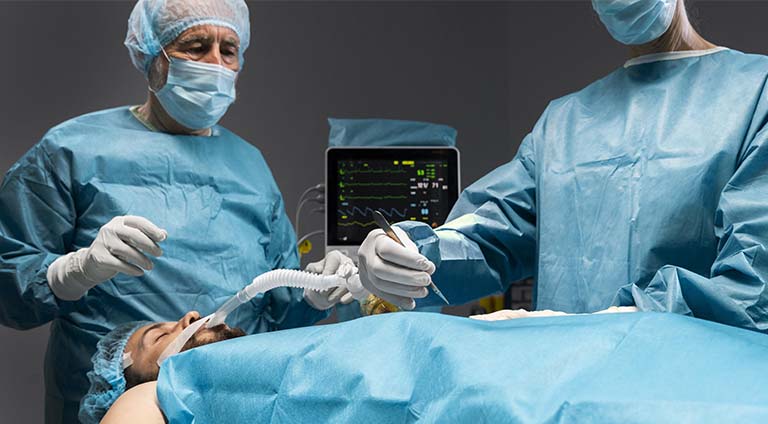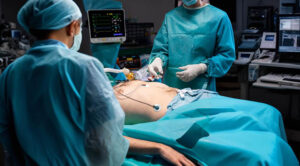What is Coronary Artery Bypass Graft Surgery?
Coronary artery bypass graft surgery (CABG), in layman’s terms, is a heart bypass surgery that ensures restoration of ‘normal’ blood flow to the heart. It is required to treat acute coronary artery disease (CAD), which is the fallout of the narrowing of coronary arteries. Well, to make you understand better, these are the main blood vessels that supply nutrients and natural oxygen to the muscles in the heart. When there’s a build-up of fatty materials like wax within the walls of arteries, it causes severe coronary artery disease. The fat inside the arteries narrows or partially restricts the passage of oxygen-rich blood, ultimately resulting in blockages and heart failures. In short, this surgery helps improve blood function.
Four Main Types of CABG Surgery
- Off-Pump CABG
- Minimally Invasive CABG – Keyhole Procedure
- Robot-Assisted CABG
- Hybrid Surgical Procedure
How is it Done?
In this precision-oriented surgery, healthy blood vessels from the wrist and veins from the leg or chest are taken and grafted in the heart, replacing the infected ones. The healthy vessel is connected just below the blocked heart artery. This procedure enables the creation of a new route for the blood to flow, bypassing the blocked coronary arteries. In a traditional CABG or “open heart” surgery method, the heart is fully stopped, and a heart-lung bypass machine takes over the job of pumping blood in the body while the surgery is on.
To begin with, a cardiac surgeon makes an incision in the center of your chest and then splits open the Sternum (breastbone) down the middle, thereby lifting the rib cage for accessing the heart. The harvested blood vessels are then crafted for the bypass graft procedure, with the upper end attaching to your aorta and the lower end attaching to the blocked artery. Once the surgery is done, the cardiothoracic/cardiac surgeon will restart the stopped heart, gently lower the raised rib cage, and lastly, seal the incision made in your chest with precise stitches.
Benefits of Coronary Artery Bypass Graft Surgery
Well, being a traditional method of heart surgery, it seldom fails. It has a high success rate, with a long history of surgeons performing CABG since the 1960s. Secondly, this low-risk invasive procedure is perfect for multiple blockages in arteries, unlike blockages in a single artery, where stenting (stent) works fine. It offers long-lasting results, including a higher survival rate than any other surgical method. Lastly, unlike others, there’s a lower requirement for follow-up procedures in CABG. Meanwhile, there’s a greater need for follow-up in angioplasty after some time.
Who Needs CABG Surgery?
People with acute heart conditions and severe symptoms may require a CABG procedure to cure their coronary artery disease, thereby reducing the risk of heart failure. Individuals with the below-mentioned symptoms and conditions ‘may’ require a heart bypass surgery.
- Serious heart failure
- Acute chest pain (angina) with CAD
- Severe tiredness and fatigue
- Increased palpitations
- Abnormal heart beats
- Continuous and prolonged shortness of breath
- Abnormal swelling in the hands and feet
Why a Heart Bypass Surgery or CABG Procedure?
A coronary artery bypass graft surgery is mainly done to restore the normal, steady, and continuous blood flow around a blocked artery in the heart. This is a kind of emergency surgery for patients who have suffered a mild or severe heart attack, thereby restoring the Status Quo. Your cardiac surgeon may recommend a CABG procedure if you have the following:
- A severe blockage in the main artery of your left heart. This artery supplies the maximum amount of blood to the heart muscle.
- Excessive build-up of ‘fatty materials’ or fat inside the main artery, narrowing the passage of blood.
- Severe chest pain arising out of constricted arteries at certain points and areas.
- An infected heart artery, with the heart’s lower left chamber not performing up to the mark.
- A critically blocked heart artery that cannot be treated even with angioplasty.
- An angioplasty procedure that didn’t work well, or an artery that has narrowed once again after some years, even after installing a stent.
Recovery Time and Medication
Most patients undergoing a heart bypass surgery may require several weeks to a couple of months to recover fully from this highly invasive surgical procedure. During this period, your cardiac surgeon will tell you which strenuous activities you must refrain from to put minimal stress on your heart and the incision. Your doctor will tell you the approximate time to recover and when you can resume regular activities in a phased manner.
Coming to the medication part, it is essential to take the medicines exactly as prescribed by your doctor in order to recover fast. If you have any queries about how to take the medicine or store it properly, always consult with your physician, as he/she will advise the most appropriate method.
Best Places in India to Get a CABG Surgery Done
Many centers of excellence and specialty clinics/hospitals in India perform coronary artery bypass graft (CABG) or open-heart bypass surgery. However, you need to consider some key factors before shortlisting one. First and foremost is the price factor, as one such critical invasive surgery may cost you around INR 1.5 Lacs – 6 Lacs, depending upon the hospital, surgeon, surgical process, and the overall criticality of the situation. There are some excellent facilities and doctors in the southern part of India, but if you’re looking for an affordable yet 100% result-oriented procedure, check out the best-in-class CABG or heart transplant surgery Surat from a highly experienced surgeon like Dr. Aditya Lad, a senior most cardiac surgeon in India, with the likes of the best in the world.





